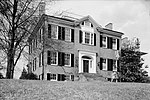Six Flags America
Six Flags America is a theme park and waterpark located in the Woodmore CDP of Prince George's County, Maryland, near Upper Marlboro, adjacent to the Washington, DC metropolitan area. Founded as a wildlife center in 1973 by Ross Perot, ABC television operated the park as a drive-through safari called The Largo Wildlife Preserve, from 1974 until its closure, in 1978. The property was bought by Jim Fowler's Wild Kingdom; thereafter, the site was gradually converted from a wildlife preserve into a theme park named Wild World. In 1992, the park was renamed “The Great Escape: Adventure World” after being acquired by Premier Parks, before being edited again to “Adventure World: The Thrill Park”. Ultimately, the park would be rebranded as the tenth Six Flags park, after Premier Parks acquired Six Flags Inc., and adopted its name, in 1999; the name-change to Six Flags America—and all associated IP and theming—was unveiled for the park’s 2000 operating season. The "America" in the park's name was chosen due to the park's close proximity to the U.S. capital; the park’s entry plaza and “promenade” also features colonial-era architecture and related theming of Colonial Maryland.
Excerpt from the Wikipedia article Six Flags America (License: CC BY-SA 3.0, Authors).Six Flags America
Central Avenue, Bowie
Geographical coordinates (GPS) Address Phone number Website External links Nearby Places Show on map
Geographical coordinates (GPS)
| Latitude | Longitude |
|---|---|
| N 38.9062 ° | E -76.77257 ° |
Address
Six Flags America Amusement Park
Central Avenue 13710
20721 Bowie
Maryland, United States
Open on Google Maps










